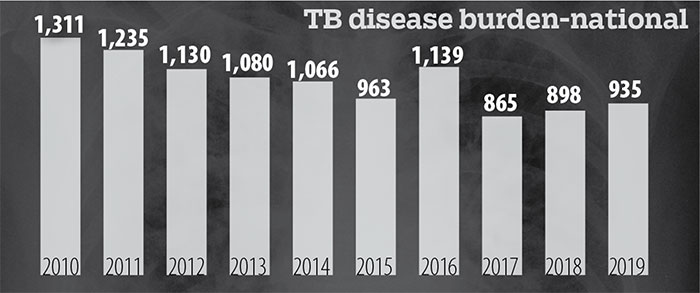Programme plans to achieve zero TB cases by 2030
Younten Tshedup
Tuberculosis (TB) continues to be a major public health problem in the country with the disease affecting close to 1,000 Bhutanese every year.
The National TB Control Programme (NTCP) reported 1,016 TB cases last year alone. According to the World Health Organisation (WHO) 2020 Global TB Report, an estimated 1,300 all forms of TB cases are seen in Bhutan.


Although there has been a slight decrease in incidence of TB in the last decade, multidrug-resistant (MDR) TB has increased over the years, which is more concerning.
In the last five years, MDR TB has annually increased by about 15 cases on an average with 70 cases detected last year. As of November 16, there were a total of 781 TB cases (all forms) reported to the programme of which 54 were MDR TB. The disease has also killed 21 people so far this year.
Bhutan today has one of the highest incidences of MDR TB cases in the South Asian region. MDR TB is caused by TB bacteria (Mycobacterium tuberculosis) that is resistant to at least two medications – isoniazid and rifampin – the two most potent TB drugs. These drugs are used to treat all persons with TB.
TB still a public health concern
Officials from the National TB Control Programme during a review meeting yesterday said that majority of the victims are in the age groups of 15-44, indicating that the disease burden is on more the prime age groups.
Besides reducing the productivity of those infected, the disease also has a significant burden on the economy as people need extensive treatments.
Like other communicable diseases, TB can spread from one person to another very easily when a sick person with TB expels bacteria into the air by coughing or sneezing.
Officials from the programme said that delay in diagnosis, as people with signs and symptoms remain unaware of the disease, increases the risk of exposure. This, along with non-compliance to TB infection control and prevention, such as cough etiquette, wearing of face masks, practicing physical distancing and hand hygiene further increase the risk of transmitting the disease.
Progress not acceptable
Health Minister Dechen Wangmo said that despite having the control programme since 1976, the country was still grappling with increasing cases annually. She said that as a small country, struggling to contain TB cases was unacceptable. “The same challenges and issues of lack of coordination and cooperation among stakeholders in addressing TB are still being highlighted today.”
Lyonpo said that it was important to implement the lessons from the past review meetings to help people on the ground. “There is a huge gap between what we envision and draft on paper versus the reality on ground. We have to work to bridge this gap.”
She said that many programmes in the country start off well and almost 70 percent of the works are executed as planned. However, when it comes to the remaining 30 percent, complacency begins to set in.
An ambitious plan set by the NTCP is to end TB by 2030 through new modality of intensified contact tracing. However, Lyonpo said that majority of the Bhutanese today do not know how TB is even spread.
“Today we are not even tracing the contacts of the MDR patients. At our current pace, 2030 would be a huge challenge for us,” she said, adding that the plan could turn out like the malaria elimination plan, which the country has been pushing so far. “If we don’t act now, fatigue will set in after a while and then the global agenda would have then changed.”
Contact tracing
Dr Tandin Zangpo of the NTCP said that contact tracing over the years is more organised, streamlined and strategic to screen contacts of the TB patients and among high-risk groups.
This he said was done to address the current challenges of finding missing cases and to close the detection gap. As per WHO, the estimated incidence of cases of TB in Bhutan in 2018 was 1,100. However, the cases notified to the programme were 918. Similarly, the estimate last year was 1,300 cases but the notification was 1,016.
Officials said that a standard operating procedure (SOP) was also being developed with clear flow of communication and reporting channel, a defined timeline to conduct contact tracing, and to carry out required investigation in the field.
As of June, this year, six positive cases were detected through the contact tracing with a detection rate (mid-year) of 1.22 percent.
Health Secretary Dr Ugen Dophu said that while progress was being made, it was not good enough for a small population like Bhutan to have a detection rate of 1.22 percent against the global rate of 3.5 to 5.5 percent. “As a small population, we can do better and we must do better.”
Lyonpo said that it was time people came together and built on the lessons learned from the pandemic, and worked towards addressing the TB issue in the country. “If we can quarantine some 21,000 plus people to prevent the outbreak of Covid-19, we better be good at quarantining people with MDR TB.”

